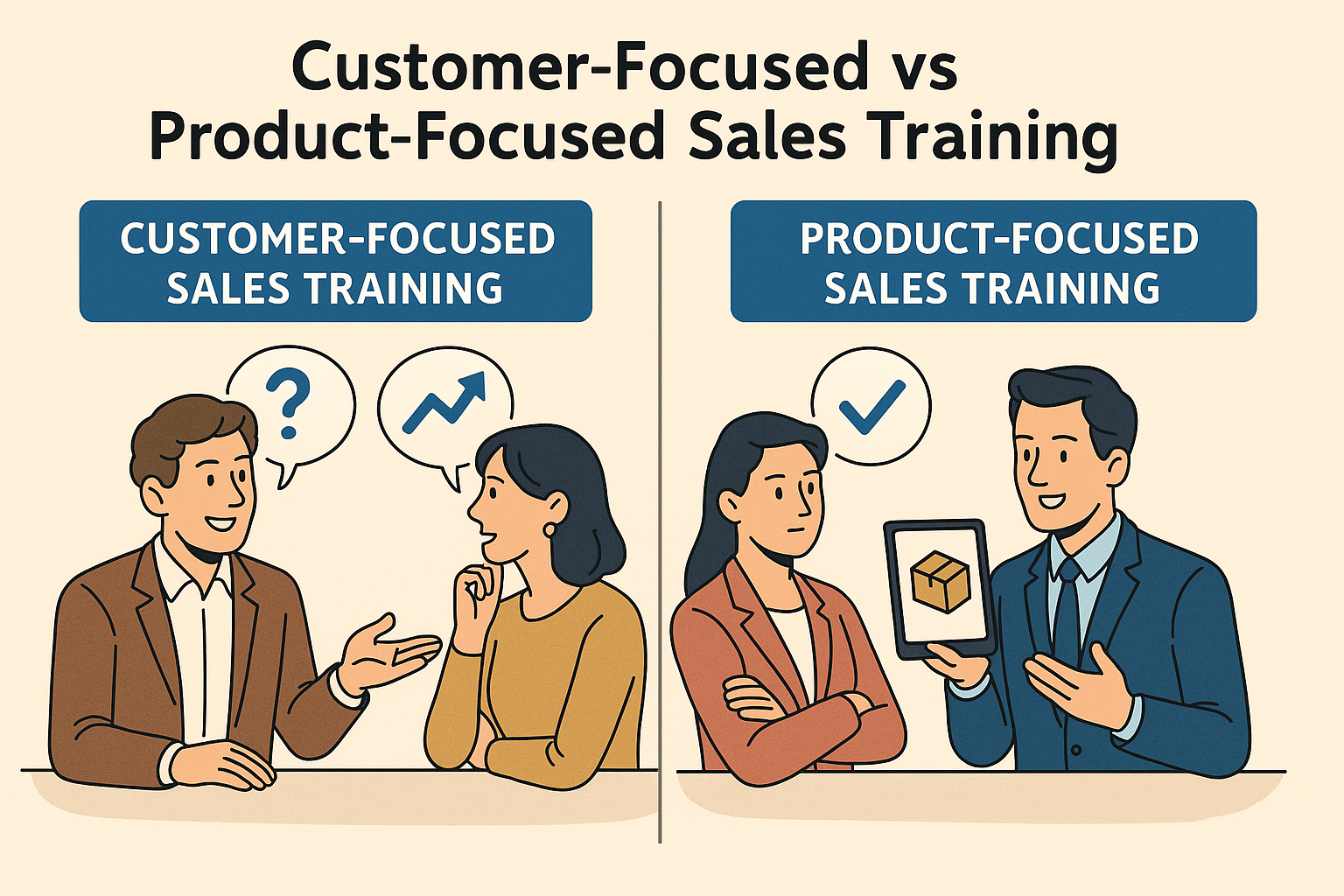Customer-Focused vs Product-Focused Sales Training: What Truly Drives Sales Success?
The Sales Training Debate
When it comes to sales training, organisations across New Zealand and Australia often face a critical decision: should their sales teams be trained to lead with deep product knowledge or prioritise customer needs and relationships?
Both approaches offer value, but in a modern business landscape defined by information access, shifting buyer expectations, and increasing competition, customer-focused sales training is emerging as the clear winner. This article breaks down the key differences and explains why a customer-first approach is essential for long-term sales success.
What is Product-Focused Sales Training?
Product-focused sales training centres on building deep knowledge of a company’s products or services. The goal is to equip salespeople with the technical proficiency needed to:
-
Explain features, specifications, and pricing
-
Demonstrate technical functionality or performance
-
Emphasise unique selling points (USPs)
-
Compare offerings with competitors
This approach is especially common in industries like technology, pharmaceuticals, manufacturing, and engineering, where sales professionals must convey complex product information clearly and accurately.
However, the focus is often on delivering a consistent, pre-prepared pitch—one that risks overlooking the unique circumstances of each customer.
What is Customer-Focused Sales Training?
By contrast, customer-focused sales training shifts the emphasis away from the product and towards the person. It trains sales professionals to:
-
Understand the customer’s context, pain points, and objectives
-
Ask insightful, open-ended questions
-
Practise active listening and emotional intelligence
-
Position products as solutions to real-world problems
The outcome? Sales conversations that feel personalised, relevant, and value-driven. Instead of being perceived as pushy or transactional, customer-focused salespeople become trusted partners in their client’s success.
Key Differences Between the Two Approaches
| Aspect | Product-Focused Training | Customer-Focused Training |
|---|---|---|
| Primary Focus | Product features & specs | Customer needs & goals |
| Sales Method | Structured, technical presentation | Tailored, consultative conversation |
| Style of Interaction | Informative, fact-heavy | Empathetic, relationship-driven |
| Sales Objective | Immediate deal closure | Long-term value creation |
| Training Tools | Product manuals, sales scripts | Buyer personas, customer journey maps |
Why Product-Focused Training Falls Short in Modern Markets
Today’s buyers are more informed than ever. Whether you’re selling software in Sydney or services in Wellington, chances are your prospects have already done their homework.
A purely product-centric approach often leads to:
-
Redundant information delivery
-
Missed emotional connection
-
A lack of adaptability in conversations
Salespeople who rely solely on features and benefits may sound robotic, insincere, or disconnected from the customer’s actual challenges. This approach can damage trust and reduce the likelihood of closing the deal.
The Power of Customer-Focused Sales Training
Customer-focused sales training empowers sales professionals to engage at a deeper level. Here’s what that looks like in practice:
✅ They build immediate rapport and emotional connection
✅ They uncover motivations and frustrations beneath the surface
✅ They adapt their pitch to suit different industries, personalities, and pain points
✅ They elevate the conversation from selling to problem-solving
In relationship-oriented cultures like those in New Zealand and Australia, where trust and reputation drive buying decisions, this approach leads to:
-
Increased customer loyalty
-
Higher referral rates
-
Reduced price sensitivity
-
Sustainable business growth
Real-World Scenario: A Tale of Two Sales Reps
Product-Focused Rep:
Jane walks into a client meeting and begins explaining her company’s software features. She runs through a demo and shares a brochure with pricing tiers. The customer listens politely, but the conversation remains surface-level.
Customer-Focused Rep:
Meanwhile, Sam starts by asking about the client’s current processes. He listens as they describe inefficiencies, frustrations, and goals. Then—and only then—does he introduce a specific software feature that directly addresses one of their core problems.
Who’s more likely to be remembered, trusted, and chosen?
Why Customer-Focused Sales Training is the Superior Strategy
Ultimately, sales isn’t about the product—it’s about the person buying it.
Customer-focused sales training leads to:
-
Deeper client relationships
-
Stronger customer satisfaction
-
Higher average deal size and lifetime value
-
Lower churn and better renewal rates
Product knowledge is still essential—but it should support the conversation, not lead it.
Final Thoughts: Evolve Beyond the Pitch
The role of the modern salesperson is evolving. To remain competitive in Australia and New Zealand’s dynamic markets, sales teams must transition from being product experts to customer consultants.
If your salespeople are still focused primarily on what they sell, they may be missing out on what really drives decisions: trust, understanding, and relevance.
Ready to transform your team?
At Integrity Solutions Centre, we deliver customer-focused sales training programmes tailored to the unique needs of Australian and New Zealand businesses. Let us help your team build the skills, mindset, and confidence to sell with integrity—by putting the customer first.
